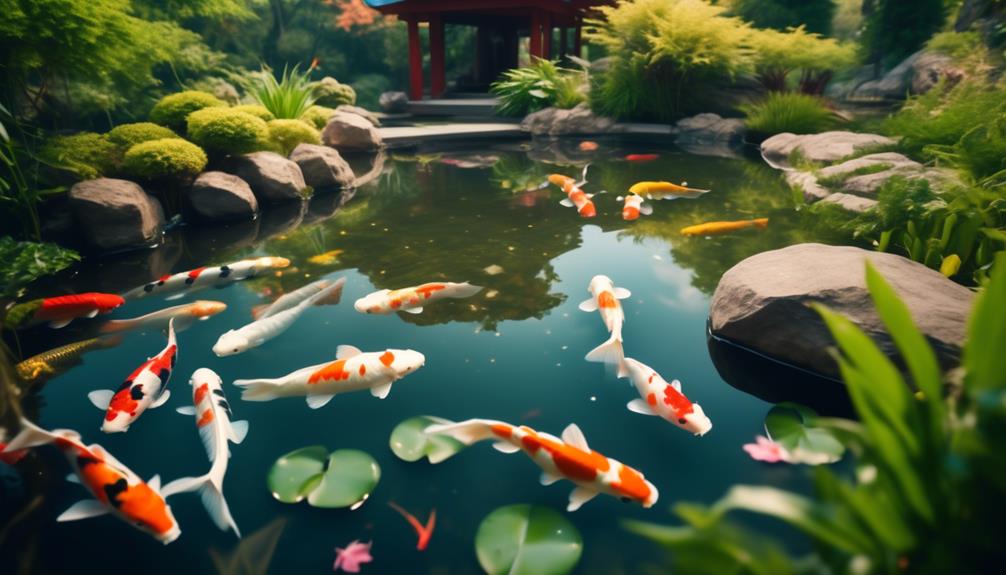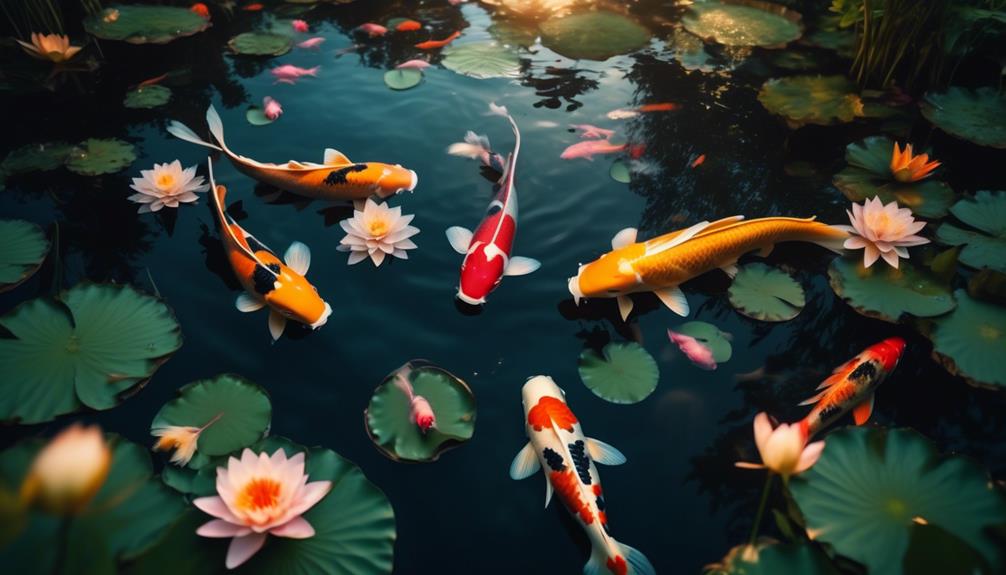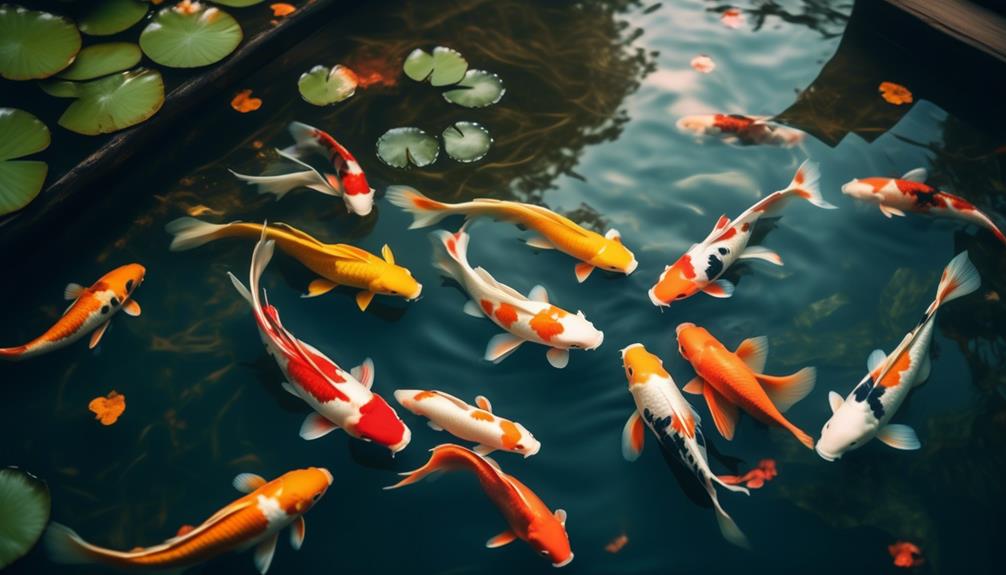Caring for a koi pond involves understanding how koi, also known as Cyprinus rubrofuscus, reproduce. It's important to know that when koi spawn, they might look like they're fighting because they chase each other a lot. But this is normal, and pond owners shouldn't worry unless they see real signs of fighting.
To help koi spawn successfully, pond owners need to make sure their pond has the right plants, the water is warm enough, and there are places where koi can lay their eggs. This is important because it helps keep the koi healthy and the pond in good shape.
Here's what you should look out for: First, the koi will get more active and start chasing each other. This usually happens when the water gets warm in the spring. To prepare, make sure your pond has plenty of plants and clean water. This gives the koi places to stick their eggs. You can also get special spawning mats or brushes to give the eggs a safe place to stick.
Remember, keeping the pond environment right helps your koi thrive. Warm water, clean conditions, and the right kind of plants and spawning places will make sure your koi can reproduce without stress. This keeps your pond looking beautiful and your koi happy and healthy.
Key Takeaways
Maintaining the health of koi fish and their ability to reproduce involves distinguishing between their typical mating activities and actual aggression. Preparing the pond, having an appropriate ratio of males to females, and maintaining water quality are essential. These steps support the growth and health of juvenile koi.
For instance, in spring, if koi are seen chasing each other, it's usually part of mating. However, if they start to harm each other, that's a sign of trouble. A well-kept pond results in healthier, more vibrant koi with potentially longer lifespans.
Proper care for young koi and their habitat involves actions such as using a high-quality water filter to maintain water cleanliness. This is important because clean water prevents diseases and promotes the well-being of the koi.
To sum up, ensure your pond is well-maintained to differentiate between healthy breeding behavior and harmful fighting among koi fish. A balanced environment where the fish can thrive is crucial for their health and successful breeding.
Understanding Spawning Behavior
Knowing how koi fish reproduce is key to keeping a healthy pond.
They start to spawn when the water is warm enough, around 18-20°C. During spawning, male koi chase the females until the eggs are released.
The females need something like plants or special mats to lay their eggs on. It's important to have the right number of male and female koi to prevent the females from getting hurt.
After the eggs are laid, it's crucial to keep the water clean to help the fish recover and stop fungus from growing on the eggs.
Identifying True Aggression
Koi fish sometimes look like they're fighting when they're actually just spawning. But if they're really being aggressive, you'll notice they keep attacking the same fish over and over. The fish being attacked might end up with injuries like torn fins or missing scales, and it might get pushed away from the group.
Aggression can happen if there are too many koi in a small space, or if there are more male koi than female koi, which makes them compete more. It can also happen when you put new koi in the pond and it messes with the pecking order.
To stop the koi from being mean to each other, you can make the pond bigger or add places for them to hide. It's also good to have an equal number of boy and girl koi. When you get new koi, don't just toss them in; let them get used to the water and the other fish slowly.
It's important to keep an eye on how the koi are acting so everyone is happy and the pond stays peaceful. When koi are friendly, they're healthier and your pond looks nicer.
Preparing the Pond for Spawning

To have a successful breeding season for your koi, it's important to make sure their environment is just right. This means setting up the pond with the right plants, hiding spots, and water conditions that koi need to lay their eggs and raise their young.
Here's what you need to do:
- Plants: Add some water plants. Koi eggs stick to them, so they're essential.
- Hiding Spots: Put in some rocks and special spawning brushes. These give koi a safe place to spawn.
- Water Quality: Keep the water clean and the pH level steady. You'll need a good filter to keep up with the extra waste from spawning.
Why do these things matter? Well, plants aren't just for egg attachment; they also help keep the water oxygenated and healthy. Hiding spots are crucial because they make the koi feel secure, which is super important for them to spawn. And keeping the water quality high is a no-brainer – it's all about giving the fish and their babies a clean and safe home.
Consider using specific products like anacharis or water lettuce for vegetation, and spawning mops or brushes that are designed for koi ponds. For water quality, a biofiltration system is a great choice to keep things balanced.
Remember to keep things simple and clear when you're setting up your pond for spawning. It's not just about throwing in a few rocks and plants; it's about creating a space where koi can thrive and reproduce successfully. So, give your fish the best chance by being thoughtful about your pond's setup.
Managing Post-Spawning Conditions
Once the koi have finished spawning, it's important to get the pond back in good shape for the health of the adult koi and the baby fish, called fry.
Improving Water Quality After Spawning
- Check the water for ammonia, nitrite, and pH to make sure it's safe.
- Change some of the water to get rid of waste.
- Add more air to the water so the fry have enough oxygen.
Taking Care of the Pond and the Koi
- Clean out things like leaves and leftover food so they don't rot.
- Look at the adult koi for any cuts or scrapes and treat them.
- Make sure there are places in the pond where the fry can hide from bigger fish that might eat them.
What to Feed the Koi
- Start feeding the koi again with food that's easy for them to digest.
- Give the fry special food that helps them grow strong and healthy.
- Keep an eye on how much you feed them to keep the water clean.
Doing these things helps keep the pond a safe place for koi after they have laid their eggs.
Caring for Koi Fry

Raising healthy koi fry is all about giving them the right food and living conditions. Right after they hatch, these little fish need food that's packed with protein to help them grow quickly. You can feed them tiny organisms like infusoria, baby brine shrimp, or high-protein food made just for baby fish. As they get bigger, it's important to mix in some crushed koi pellets with their food to make sure they get all the nutrients they need.
Water quality is super important for koi fry. You've got to keep an eye on the water temperature, pH, and ammonia levels to make sure they're just right. Since baby fish can easily get sick from germs in the water, a good filter that can clean the water both mechanically and biologically is something you can't do without. Also, adding plants and places for the fry to hide can help them stay safe from predators and deal with any tough conditions in their pond.
For example, if you're looking for a good filter, you might want to try one that's designed for koi ponds and has both mechanical and biological filtration functions. This kind of filter will help keep the water clean and safe for your growing fry.
Selecting Quality Spawn
When choosing the right spawn for breeding koi, it's important to look at their family background, health, and appearance. These factors play a big role in producing healthy and attractive koi:
- Family Background
- Know their ancestors to guess what traits the baby koi might have.
- Learn how certain traits are passed down, like body shape or fin size.
- Health Check
- Look for fish that swim well and eat eagerly.
- Check for any illness or parasites.
- Find out if their parents were healthy to predict a strong immune system.
- Looks
- Go for koi with bright and clear colors.
- Make sure their patterns look good together.
- Think about how young koi might change as they grow.
It's really important to be thorough when breeding koi if you want to see great results.
Balancing Koi and Goldfish

Creating a balanced pond for koi and goldfish means paying close attention to how many of each fish there are and how they breed. Koi can be rough when they spawn, which can be a problem for the smaller goldfish. However, goldfish can also have a lot of babies, which can upset the balance in the pond. To keep things in check, watch how many male and female koi you have; too many males can cause chaos during breeding season. It's a good idea to put in special areas for koi to spawn safely. Keeping the water clean and healthy is key for koi to heal after breeding and for baby goldfish to grow up without taking over the place.
Why is this all important? Because a well-managed pond means healthier, happier fish. For instance, if you have more male koi than females, the males might chase the females too much, which can hurt the females and stress them out. To avoid this, you could use a ratio of one male to every few females. And when it comes to spawning areas, think about adding plants or spawning brushes where koi can lay their eggs without damaging themselves or others.
Don't forget about the water itself – it's like the air we breathe for the fish. Test it regularly and use filters or water treatments to keep it clean. This helps the koi recover after they've had their eggs and stops the goldfish babies from crowding the pond.
In a nutshell, keep an eye on your fish numbers, provide safe places for koi to breed, and take care of your water. Doing these things will help all your fish to flourish together.
Maintaining Healthy Water Quality
For healthy koi fish, it's crucial to keep their water clean. This means checking and adjusting water chemistry often. Here's what to look out for:
- pH Levels: Keep them between 7.0 and 7.8. If the pH swings too much, the koi can get sick.
- Ammonia: Aim for zero. Ammonia comes from fish poop and rotting stuff like leaves.
- Nitrite and Nitrate: Nitrite should be almost zero, and nitrate should be below 20 ppm.
To do this:
- Test the water often with good test kits.
- Use filters that have bacteria to break down waste.
- Change some of the water regularly to get rid of extra nutrients and dirt.
By keeping an eye on these factors, you can help make sure your koi are healthy and their pond looks great.
For example, using products like the API Freshwater Master Test Kit can help you keep track of pH, ammonia, and nitrate levels easily. And including a biological filter like the Fluval FX6 Canister Filter will tackle waste efficiently.
Frequently Asked Questions
How Can I Differentiate Between Playful Chasing and Harmful Aggression Among Koi During the Spawning Season?
To tell if koi fish are just playing or actually fighting, watch how long and how hard they chase each other, look for any injuries, and see if the way they act in the pond changes. It's important because aggressive behavior can hurt the fish and change the balance of your pond. For example, if you see a koi with ripped fins or if they hide all the time, this could mean they are being bullied. A good transition between playful chasing and aggression is if the chasing doesn't stop and some fish seem scared or hurt. Always choose active voice to make things clear, like saying "A koi chases another" rather than "One koi is being chased by another." If you need to handle aggression, consider adding hiding spots or using products like water conditioners to reduce stress. Keep your writing natural and easy to understand, just like if you were talking to someone about your koi pond. Remember to give full details, so people can really see what's happening with the fish.
What Are the Signs That Indicate a Female Koi Is Over-Stressed or Injured Due to the Spawning Process?
When female koi are going through the spawning process, it can be tough on them. You'll want to keep an eye out for signs that they are not doing well. If you see scratches or marks on their head or sides, it's often a sign they've been hurt. Also, if they're not moving much or they're staying away from other fish, that's not a good sign. It's important because these signs can tell us if the fish is in trouble and needs help. For example, if a female koi is hiding all the time and not eating, you might need to check the water quality or give her a safe place to rest. Remember, healthy fish are usually active and social. If you notice these changes, it's a good idea to act quickly to help your koi recover.
Are There Specific Times of the Year or Conditions That Are More Conducive to Koi Spawning?
Koi fish often spawn when it gets warmer, typically in the late spring to early summer. During this time, the water gets warm enough, usually around 65 to 75 degrees Fahrenheit, which is just right for them to start their breeding. This happens because warmer water makes the koi more active and triggers their natural breeding instincts. It's important for them to breed during this time because the conditions help ensure that the eggs will develop properly and the baby fish, or fry, will have a better chance of survival.
For koi keepers wanting to encourage spawning, it's key to monitor water temperatures and ensure the pond environment is clean and well-oxygenated. Adding plants and creating shallow areas in the pond can also mimic natural breeding grounds, making it more inviting for koi to spawn. Regular maintenance, such as removing debris and maintaining good water quality, will also support the health of both adult koi and their offspring.
How Can I Ensure That the Male-To-Female Ratio in My Pond Is Optimal for a Successful Spawning Season?
To make sure your pond has the best chance at a good spawning season, it's important to have an equal number of male and female fish. This balance helps the fish mate successfully and can lead to more baby fish. For example, if you have a pond with koi fish, aim for a 1:1 ratio of male to female koi. This not only increases the chances of eggs being fertilized but also reduces aggressive behavior among males competing for mates.
To achieve this, you might need to add or remove fish to get the numbers just right. If you're not sure of your fish's genders, you might ask a local fish expert or use a guide to help you identify them. Sometimes, it's also useful to add structures like plants or spawning brushes where fish can lay eggs, making the environment more conducive to spawning. Remember, a pond that has too many males could lead to fewer eggs being fertilized, while too many females might mean not enough eggs are fertilized. Keep an eye on your fish during the breeding season to make sure everything is going smoothly.
Can Human Interaction or Interference Disrupt the Koi Spawning Process, and if So, How Can We Minimize Our Impact?
People can indeed disrupt fish, like koi, when they are trying to spawn. To help them, we should keep noise low and not bother them too much. This is because a peaceful setting is needed for fish to reproduce successfully. For example, if you're near a pond during spawning season, it's best not to throw stones or run machinery that makes a lot of noise. Also, it's good to have plants and clean water in the pond, as these create a better home for koi to lay their eggs. Remember, happy and healthy fish are more likely to have babies, so taking care of their environment is key.
Conclusion
To keep koi fish healthy and ensure they breed successfully, it's important to tell the difference between their normal mating behavior and actual fighting. Getting the pond ready, keeping the right number of male and female fish, and looking after the water are all key steps. These actions help baby koi grow well.
For example, if you notice the fish chasing each other in spring, it's likely for mating, but if they're injuring each other, that's a problem. A well-managed pond means the koi will look better and live longer.
When koi have babies, the right care makes sure they and their environment stay healthy. To do this, for instance, you might use a high-quality water filter to keep the water clean.

